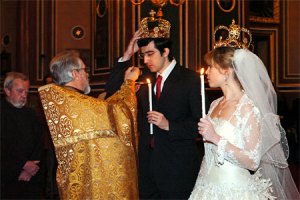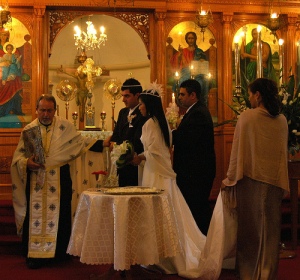This is the first part of a two-part video recording from a truly holy and erudite man (retired Archbishop Lazar, founding abbot of All Saints Monastery in British Columbia) on the deep theological and liturgical significance of the crowning ceremony to marriage and salvation in Orthodox Christianity.
At the height of the ceremony, the bride and bridegroom are crowned and communed together as equal partners in a mystical union joining them forever in shared devotion and loving self-sacrifice to each other. The husband is an icon or type of Christ, the eternal Bridegroom who cherishes and honors the Church more than Himself (Ephesians 5:25), and the wife is an icon or type of the holy Church, the eternal, loving Bride of Christ.
Vladyka Lazar explains that the Western Christian tradition of the father of the bride walking his daughter down the aisle to meet her waiting groom is historically absent from Orthodoxy. The handing over of the bride by her father to her new husband recalls the ancient pre-Christian Roman and Greek patriarchal practice whereby fathers symbolically transferred their power and authority (potestas and auctoritas) as paterfamilias over their daughters to the husband, who then automatically assumed her into his authority and family, effectively erasing her independent legal existence.
Since in Orthodoxy, by contrast, bride and groom come to the altar as equal partners, they walk there together after first making their vows and exchanging rings at the entrance to the temple. Then, with the priest or bishop presiding, they are mystically joined together by the grace and power of God during the Liturgy, a mystical transformation which recognizes the close bond of love they already share.
Unlike in Western Christian ceremonies when the couple is considered married from the moment when the presiding clergyman pronounces them as such following the exchange of vows, there is no set moment in the Orthodox crowning ceremony when the couple is considered automatically joined in marriage.
Their crowning three times by the celebrant, who exchanges the crowns between their heads, symbolizes their mystical union and their equality in partnership before God as king and queen of a new ‘little church’, a new family. The traditional Byzantine bridal crowns, called stefania, explain the etymology of the name Stephen.

The priest crowns the couple, moving the crowns over their heads three times while intoning the doxology, before setting them on their heads. From this point, the husband, an icon of Christ, is mystically transformed as king over the family, and the wife, an icon of the Church, as queen over the family.
The couple can be considered married by the time they first commune together of the holy Mystery of the Eucharist as husband and wife and walk around the altar, on which rests the chalice, patens, and the Holy Gospel, to the solemn hymn of witnesses. This walk symbolizes both a religious procession of pious faith by the married couple, now a holy unit, and is the moment from which they take their first steps together in their new union.

After their crowning, the husband and wife take their first steps in a procession three times around the altar, reverencing the holy Cross and the Gospel book.
From the moment they approach the altar, they are already considered bound to each other in sight of man, and once they commune and walk together after their crowning, this mystically binds them in the eyes of God.
Please click on this helpful link for more information.

